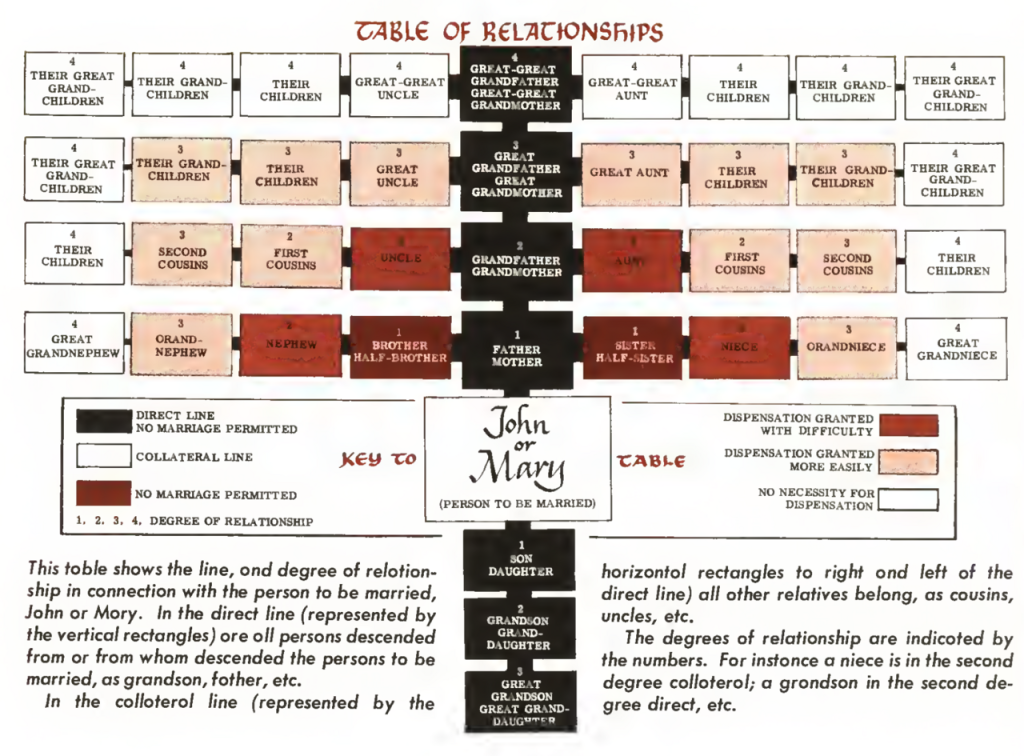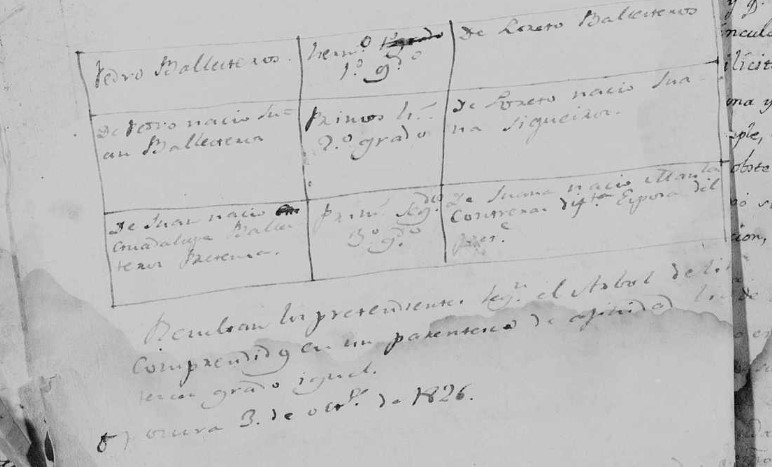If you’re one of the few who’ve looked through the records typically titled “Informacion Matrimonial” followed by years, in the record collections on Ancestry or FamilySearch you’ve likely looked at them as a lot of pages for very little information. These records are different from the records typically simply titled “Matrimonios” with years that follow. Matrimonios are fairly condensed information on the marriage providing the bride and the groom along with the parents, and witnesses and or god parents. Informacion Matrimonial, on the other hand, are the records that provide information not only on the bride and the groom, but also typically information from three witnesses who know the couple and whether there is any consanguinity.
Most of you are probably now asking what is Consanguinity?
The word “consanguinity” comes from Latin, where “con-” means “together” and “sanguis” means “blood.” Therefore, consanguinity literally means “with blood” or “blood relation.” In simple terms, it refers to how closely related two people are by birth. Now you can see why this is such a beneficial piece of information when researching a family!
In this Table of Relationships from Louis La Ravoire Morrow’s 1949 “My Catholic Faith” one can see the “degrees of affinity”, and the impediments they pose to marriage in the Catholic religion.

In most Informacion Matrimonial records I’ve looked at I find “no tiene consanguinidad” which translates to does not have consanguinity, but when as a researcher I happens upon something like “tercer grada de consanguinidad”, well my heart skips a beat with the potential information that could be included in that record. Specifically that example translates to third degree consanguinity.
The Catholic Church’s Rules on Consanguinity
The Catholic Church uses a system of “degrees” to measure how closely related two people are. These degrees help determine whether a marriage is permissible:
- First Degree: This includes direct relatives like parents and children, or siblings. Marriages between these relatives are prohibited.
- Second Degree: This includes uncles or aunts with their nieces or nephews. Marriages in this degree can have dispensation granted with great difficulty.
- Third Degree: This includes first cousins, grand niece / nephew, grand aunt / uncle and second cousins. While some might think of this as very close, the Church allows dispensation on these with greater ease.
- Fourth Degree and Beyond: This includes more distant relatives, like third cousins. Marriages in these degrees are generally allowed without any special permission.
Depending on the record and the parish priest who was requesting the dispensation on the couple’s behalf you will get little information or in the case I’ll present below a good deal of information to work off of. Depending on the location and the status of the families dispensation would have to be requested to a local bishop or sometimes to the Vatican.
Consanguinity Example – Sonora Mexico 1826
Here is an example I like simply because the parish priest was a wonderfully detailed person who was so kind as to draw future generations a table to explain the relationship. This is the record for the 1826 Sonora Mexico marriage of Don Juan Ygnacio Teran and Dona Guadalupe Ballestros. Don Juan Ygnacio is the widow of Dona Manuela Contreras and the son of Don Jose Maria Teran and Dona Gertrudis Grijalva (deceased). Guadalupe is the daughter of Don Jesus Ballestros (deceased) and Dona Antonia Escarcega. Juan Ygnacio and Gaudalupe are requesting dispensation for a more unusual reason, Guadalupe and Juan Ygnacio’s deceased wife Manuela are blood relatives.
Juan Ygnacio and Guadalupe who “estos tienen un parentesco en tercer grade de afinidad end el murio grado de sue actual pretensa pero que no lo tiene de consanguinidad y copula.” Translated: these have a relationship in the third degree of affinity in the deceased, degree of current claim, but they do not have it of consanguinity and copulation. Their relation is not blood to each other but blood to his deceased wife.
Below is the table that the parish priest drew out to explain the relationship:

On the top are siblings Pedro Ballestros (left side) and Loreto/a Ballestros (right side), Pedro has a son Juan Ballestros (left side) and Loreto/a has a daughter Juana Sigueiros (right side); Juan and Juana are first cousins. Juan has a daughter, the bride, Guadalupe Ballestros (left side) and Juana has a daughter Manuela Contreras (right side), Guadalupe and Manuela are second cousins.
Included in the records is Juan Ygnacio’s age of 48, so he born about 1778 and Guadalupe’s age of 24, so she born about 1802. In the record Guadalupe’s father is listed as Jesus, but in the table as Juan, most families of the era and location have several names so do not let this throw you for a loop.
This information taken together provides a great deal of valuable information and several lines of research to head down, depending on which parts of the family you are related to or interested in.
Further Research Opportunities
As an example, a fairly quick search indicates that Juana Maria Sigueiros’s husband was Juan Josef Contreras who was deceased by 1802 when their son Don Ramon Silverio Contreras married Dona Maria Antonia Grijalva. This also helps set parameters for birth and death of the listed families.
To provide ourselves general parameters for the years we are looking at in the table we can use other information to reasonably estimate timelines. While we do not know Manuela’s age at death, she had a brother of marrying age by 1802, even estimating that he is the oldest and subtracting 20 years for his birth, then another 20 years for his mother’s birth, we can say Juana Sigueiros was born circa 1760 and for her mother Loreto/a circa 1740. This is not done for precision, but to provide reference dates that will assist as research progresses.
When researching any family, without specific birth and dead dates, providing yourself with general parameters can help prevent those family tree errors we see where a child with the right surname is put in a tree, but was born when the mother was 80 or -20 years old.
Additional Information
Another piece of information, that’s use cannot be understated in these records, is the information about those who are giving testimony as witnesses. These individuals often state their name, where they are from and their age. So if the witness is someone in your tree this can be a gold mine. It could confirm their age or provide a source for it, it could tell you how they are related to the couple being wed and especially in the case of the movement of people into new areas it may be exactly what you need to know to know where they came from originally and where you need to search next as you work your way back in time.
To learn more about the information available in Catholic Church Records read this article.